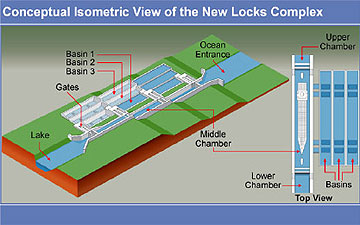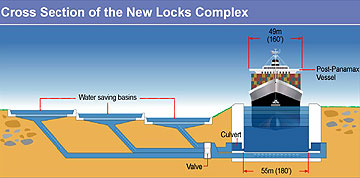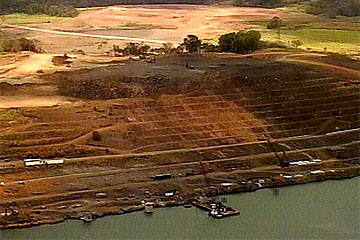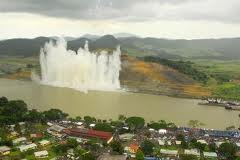(NPR.org) When Savannah welcomed the largest cargo ship ever to call on its booming seaport, the visiting vessel barely fit. The Figaro had to sail in loaded at half capacity to avoid scraping the river bottom, and even then could only navigate the shallow channel at high tide.
East Coast ports from New York to Miami simply aren’t deep enough to handle such mammoth vessels as the CMA CGM Figaro, which measures 1,100 feet long with space for 8,500 cargo containers a tractor-trailer can haul one at a time. With a major expansion of the Panama Canal projected to be finished by the end of 2014, these gargantuan vessels will be able to sail between Asia and the U.S. East Coast.
The canal expansion is pitting seaports up and down the Atlantic coast in a race to dig deeper harbors capable of handling the so-called post-Panamax ships.
“It’s going to almost triple the size of the vessels that are going to be able to transit the canal,” said Kurt J. Nagle, president of the American Association of Port Authorities. “I don’t think it’s overhyped to say it’s a gamechanger.”
The post-Panamax ships require depths of up to 50 feet of water to navigate when fully loaded. Only one East Coast seaport — Norfolk, Va. — is that deep. Other ports are scrambling for federal permits and hundreds of millions of taxpayer dollars to scrape and suck tons of sand and mud from their bays and river bottoms.
The port of New York/New Jersey, the busiest port on the eastern seaboard, already has a $2.3 billion project under way to deepen its harbor to 50 feet. But the Bayonne Bridge spanning the shipping channel is too low for the biggest ships, and port officials say at least $1.3 billion more is needed to raise the span.
Savannah, the nation’s fourth busiest container port and No. 2 on the East Coast, wants $588 million to dredge 6 feet from the Savannah River along 35 miles between the ocean and the city’s port. The federal government would pay about two-thirds of the bill, but first the Army Corps of Engineers needs approval to start the project, which is expected within the year.
“This is a project that has significance not just for this area of the state or the state itself, but for the entire Southeast,” Georgia Gov. Nathan Deal said during a Jan. 28 visit to the Savannah port.
Dock workers at the Savannah port, 240 miles from Georgia’s state Capitol, are doing their part to help push for deeper water. When the Army Corps held a recent workshop here to gather public comment on the project, the local chapter of the International Longshoremen’s Association had 600 port workers show up to voice their support.
Christopher Johnson, a second-generation longshoreman and one of the union’s 1,700 Savannah workers, said larger ships carrying more cargo should translate to more workers needed to unload them. But Savannah could lose jobs, he says, if it doesn’t dredge and its competitors do in nearby Charleston, S.C., and Jacksonville, Fla.
“If we don’t get the project done, we’re afraid the ships may go to other areas,” said Johnson, 46. “Our workload depends on the ships coming up the river. If the ships don’t come, we don’t eat.”
Meanwhile, South Carolina officials are seeking $400,000 in federal money for a feasibility study by the Army Corps to determine if it can deepen the Charleston port from 45 to 50 feet. Charleston is the East Coast’s fourth busiest container port, and No. 12 nationally.
Miami’s port already has permission to dredge and is asking for $75 million to start the project’s first phase. Studies are under way to deepen two other Florida ports in Ft. Lauderdale and Jacksonville.
“Certainly every port is counting on it having a big impact,” said Bernard Groseclose, former chief executive of South Carolina’s seaports who now works as a private consultant. “Everyone is telling the same story: We’re getting ready for the Panama Canal expansion.”
But getting funding may have just gotten tougher.
Federal dollars used for dredging projects and the studies required to approve them typically get added to congressional budget bills as “earmarks” — line items requested by individual lawmakers to benefit their districts back home. Yet earmark spending was widely denounced as government waste in the 2010 elections that swept Republicans back in control of the U.S. House.
As a result, GOP lawmakers in both the House and Senate have sworn off earmarks for the time being. It’s not clear how else port projects would obtain federal money.
“It has the potential to have a dramatic impact,” said Nagle, who insists port projects aren’t waste. “There clearly is a distinction between these types of projects and what is typically the target of the ban.”
Both Nagle and Groseclose agree not all ports seeking to supersize their harbors will get approved — and both don’t think every U.S. port needs to be deep enough for the largest ships.
But some are questioning how the federal government decides which projects move forward.
In studies finished last November that recommend deepening Savannah’s harbor, the Army Corps of Engineers concludes the project would have economic benefits for the nation as a whole — the benchmark for the agency’s approval.
But what the Army Corps hasn’t done is take a comprehensive look at all East Coast ports to determine how many should be dredged to post-Panamax depths and which would reap the most benefits for the best price.
“The Corps is evaluating the cost and benefits of these individual proposals in a vacuum,” said Chris DeScherer, an attorney for the Southern Environmental Law Center. “Where does it make the most sense on the East Coast to have a deep water port? Where does the American taxpayer get the most bang for his buck with the least environmental impact?”
The Army Corps said it hasn’t done a broader study to compare ports, in part, because no one has asked.
The Corps doesn’t have the authority to initiate port studies on its own.
“To date, there has been no request by the ports or Congress to undertake a comprehensive study,” said Jim Walker, chief of the Navigation Program for the Army Corps of Engineers.
| Canal Cruise Panama Information on Panama Canal Cruises and what else to do around the Panama Canal Panama Canal Expansion Info |
|
 Conceptual view of the new Panama Canal Locks |
Panama Canal Expansion Info: The Third Set of Locks Project is a mega project that will expand the Panama Canal. The expansion will be greater than at any time since the canal’s construction. The Panama Canal Authority proposed the project after years of study. Panamanian President Martín Torrijos presented the plan on April 24, 2006 and Panamanian citizens approved it in a national referendum by 76.8% of votes on October 22, 2006. The project will double the canal’s capacity and allow more traffic. You can find much more Information about the Panama Canal Expansion Project right here on the Official Panama Canal Website Pancanal.com. |
 Conceptual view of the new Panama Canal Locks |
|
 From the Live View Cams of the Panama Canal Expansion |
Panama Canal Expansion Info
The program consists in the construction of two new sets of locks – one on the Pacific and one on the Atlantic side of the Canal. Each lock will have three chambers and each chamber will have three water reutilization basins. The program also entails the widening and deepening of existing navigational channels in Gatun Lake and the deepening of Culebra Cut. In order to open a new 6.1 km-long access channel to connect the Pacific locks and the Culebra Cut, five dry excavation projects will be executed. |
